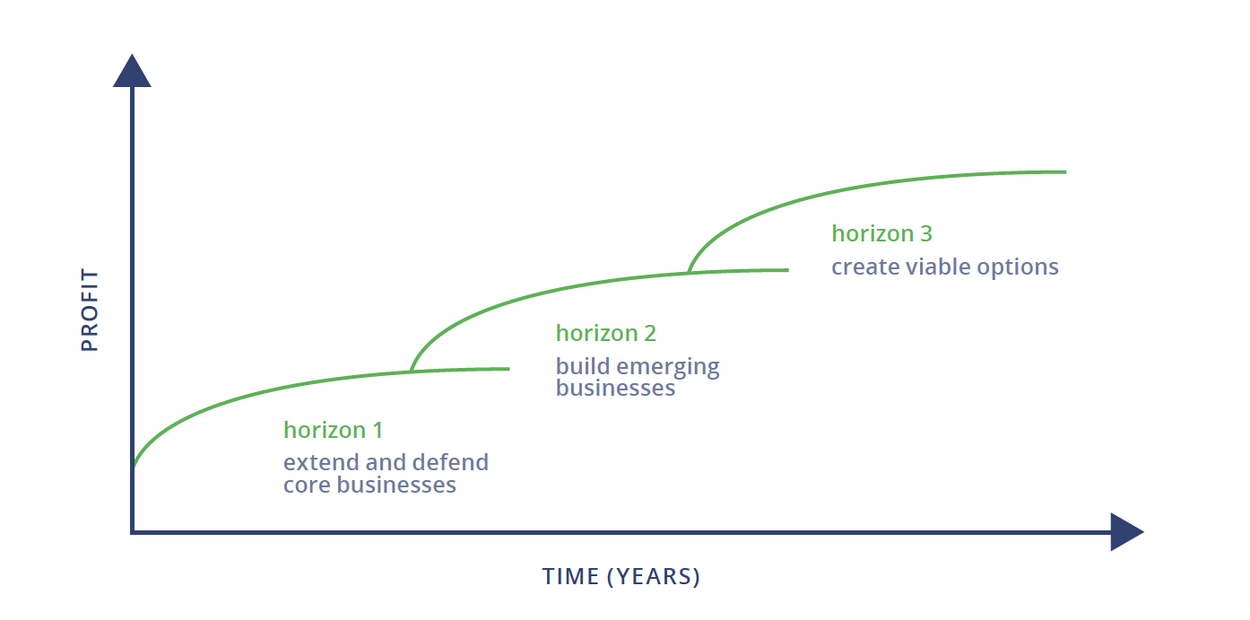In our previous blog, we talked about how building understanding is key in succesful innovation projects. It’s a first and crucial step to understand your company’s challenges and to keep your eyes and ears open for signals from the outside world. When that’s clear, it’s time to shape choices within your organisation! Gillette did, Mobile Locker did, the babysitter platform Nanyfy did. All these companies innovated differently after understanding their challenges. Let’s have a look at their story to understand the possibilities of innovation.
So, you managed to build understanding and the innovative ideas come in. Let’s take a next step: shape choices. To achieve long term continuity, organisations should develop initiatives in 3 horizons simultaneously. Let us explain what’s on the picture below (3 horizons model by McKinsey):
- Horizon 1 - incremental innovation: this may seem underrated against other types of innovation. Maintaining relevancy by doing small iterative improvements and retaining a customer elongates a company’s survival in the market. One of the most famous examples of incremental innovation is Gillette. Just Google the razor blade version in 1900 and the latest versions. Incremental innovation is about updating and extending existing products, services and processes. The objectives can be diverse: cost optimization, a higher customer experience, adaptation to enter new markets and so on.
- Horizon 2 - new innovation: this is about discovering new business models. The technology or solutions are known, but it is new for your company. The same goes for markets and customers. This is where the example of Mobile Locker comes in. Let’s first explain the 3rd horizon.
- Horizon 3 - disruptive innovation: this is the most unknown zone, but also the most thrilling part of innovation. Here you use unknown technologies, at least for your sector, and you discover new markets and target groups. This is innovation with the I of Ideation. Out of the box Ideation. In our previous blog we talked about the arrival of Netflix and the exit of Blockbuster. Video streaming on platforms is an example of a radical disruption in the history of media and entertainment. Platforms such as Netflix and our own local media solutions (eg. Streamz, VRT Nu, ..) are outstripping cable and satellite.
You probably ask yourself the question: should I go for the out-of-the-box idea, or should I spend all my time on improving an existing product? There is not one right answer. The examples show that every horizon has their own possibilities for success. The most important advice we have for you: don’t put all your eggs in one (horizon)basket and go for a balanced innovation portfolio.
Most companies spend 70% on Horizon 1, 20% on Horizon 2 and 10% on Horizon 3. But of course this depends on the type of organisation you work in (start-up vs a company with an established value) and the pace of the industry.

Let’s come back to the example of Mobile Locker and how innovation helped them to cope with the crisis. As the name implies, Mobile Locker delivers customized lockers for festivals, events, shopping centres and more. This sector was highly impacted by the corona crisis. But with the pandemic hitting hard, Mobile Locker kept on innovating.
Firstly, they had the great opportunity to be contacted by Tesla to provide them lockers for contactless key transfer to new Tesla owners. They even created lockers for food delivery solutions and to store potentially infected waste material like masks and gloves.
But they didn’t stop at these COVID-related concepts and shifted their focus from their existing market (festival & events) to more permanent set-ups. Hence, they used their existing mobile lockers to help out shopping malls around Belgium to set up 24/7 Click & Collect points, enabling them to continue doing business also during off-peak hours.
This is a nice example of a company that focuses on new innovations: they used existing technologies in their discovery of new market segments, but they’ve also done some incremental innovations to improve their products. And most probably, they’re brainstorming right now to become disruptive in the logistics market.
Another example can be found in the Spanish market: the babysitting platform Nannyfy was forced to reinvent itself. The application links families with babysitters, which was not possible during the several lockdowns. To stay relevant, they had to act quickly on this changing environment and that’s exactly what they did. They came up with an online alternative: a platform on which babysitters can do activities with the kids on a distance while the parents can have online meetings without being disturbed. Given the fact that many companies have changed their telework policy, this application will probably have a longer life.
My 5 tips to shape your choices:
- Speak with your customers as input for your incremental innovation: what are their needs, and what makes them a long lasting user?
- Look at your competitor’s website and social media pages to understand what they are doing. Just as a little inspiration.
- Make an inventory of all the company’s existing initiatives and plot them on the 3 horizons model. This will be a good starting point for a team discussion.
- Have think-out-of-the-box days with your employees to gather ideas on horizon 2 and 3: Gmail was one of Google’s 20% policy products! A hackaton with your teams is also a great team building opportunity!
- Listen to the voice of your colleagues: ‘Yes, and..’ leads to much more creative ideas instead of ‘Yes, but..’. A great tool to perform brainstorm meetings with several people is the GPS brainstorm methodology.
Already thinking about how you can apply these tips in your organisation ? Great, keep going!
Our final blog in this series, will give you hands-on tips to decide on which actions you should take.
